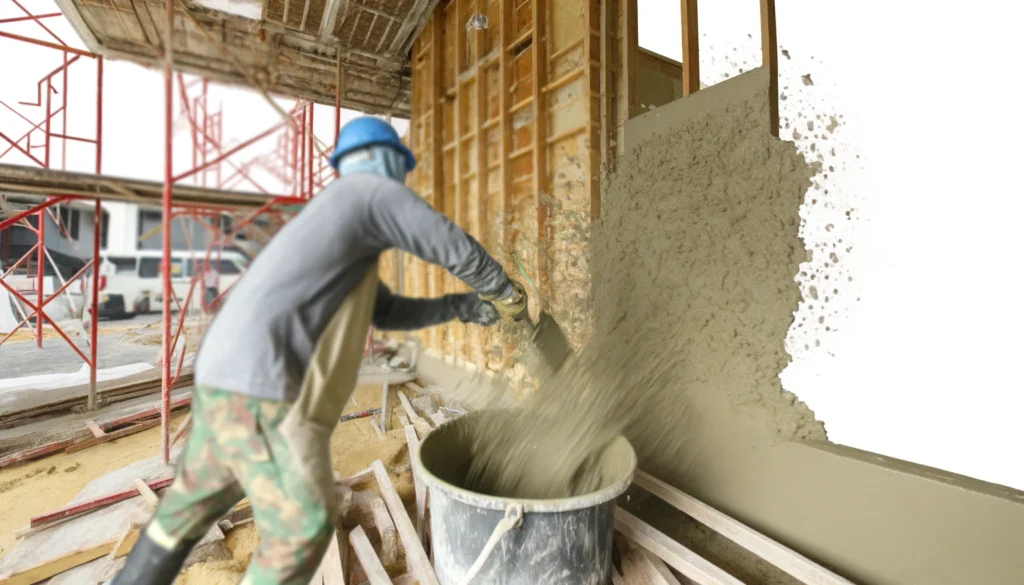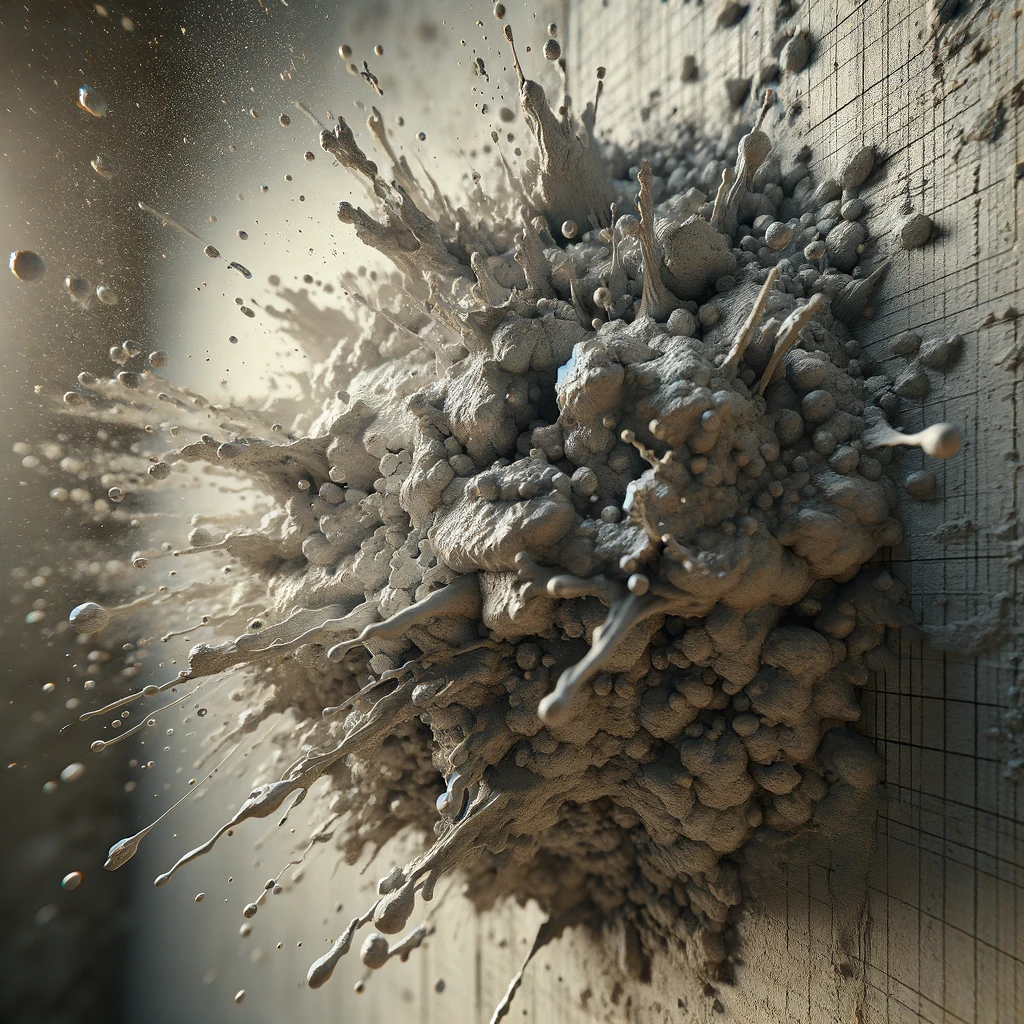Understanding Spatterdash Concrete
Spatterdash mortar is a type of wet mixture, typically comprised of cement, sand, and water.
Its purpose?
To provide a reliable adhesive base for further construction tasks.
Spatterdash’s key feature is its small and manageable size ‘splashes’, applied crudely (meaning chucked forcibly) against a surface to ensure optimal grip for the next layer of material, like stucco.
In construction, it’s like the unsung groundwork hero — creating coarse surfaces for additional wall layers. Read on to learn more.

Table of Contents
The Role of Spatterdash in Construction
While understanding when to apply spatterdash is vital, knowing ‘what’ this element is and ‘how’ it aids construction projects is equally critical. With this expansion, let’s decode what spatterdash brings to the table in the construction realm.
What is a Spatterdash?
Spatterdash, otherwise referred to as a splash coat, is a construction method involving a mixture of cement, sand, and water, used to ensure a strong bond between layers of concrete or plaster.
This mixture is manually splashed onto the existing concrete layer, creating a rough surface to which the new layer can adhere more strongly. The spatterdash not only increases the bonding strength but also helps to minimize separation and cracking.
Ingredients of Spatterdash
- Cement: The main building block of spatterdash, providing the required adhesion strength.
- Water: Necessary to activate the cement and create the right consistency for the technique.
How Spatterdash Enhances Construction?
Now that we have decoded what a spatterdash coat is, let’s explore how its use enhances construction projects.
Increased Bond Strength
As stated earlier, spatterdash primarily functions to increase the bond strength between different layers of concrete or plaster. This enhanced bond strength grants improved structural integrity and longevity.
Reduction in Cracks and Separation
The application of a spatterdash layer also results in a significant reduction in cracks and separation between the layers. This ultimately leads to fewer repairs and increased longevity of the construction.
Creates an Ideal Surface for Further Applications
Spatterdash, with its rough texture, creates an ideal surface that allows the next layer of plaster or concrete to key into place effectively, ensuring a more structurally sound finish.
How to Get the Most Out of Spatterdash Application
Here are some essential tips to effectively use spatterdash in your project:
- Ensure to use the correct mix of cement, sand, and water for effective results.
- Timely application is key; the new layer should be applied while the spatterdash is still wet for the best adherence.
- The surface should be clean and wet before application to support the bonding process.
- Avoid application during freezing or excessively hot weather for optimal results.
To wrap it up, spatterdash is not just a construction technique but a guardianship measure for the new layer of concrete or plaster. Understanding its role and proper application will undoubtedly add more years to your building’s lifespan.
Extra Information
Here are some additional resources to aid your understanding of spatterdash:
| Resource | Link |
|---|---|
| 1. “A Comprehensive Guide to Using a Plaster Bonding Agent” | diydoctor.org.uk |
| 2. “Understanding Concrete, Cement, and Mortar” | thisoldhouse.com |

When to Apply Spatterdash in Construction
The Ideal Time to Apply Spatterdash
Spatterdash should be applied immediately before the new layer of concrete or plaster. A time gap between these applications could compromise the bond.
Factors Influencing the Timing of Spatterdash
- The nature of the surface: A clean, wet surface is ideal for spatterdash application.
- Weather: Avoid applying spatterdash during freezing or excessively hot conditions.
- The readiness of the new layer: Spatterdash application should closely precede the application of a new layer of concrete or plaster.
The Importance of Timing in Spatterdash Application
Timely application of spatterdash ensures a strong bond between the old and new layers of concrete, preventing future separation or cracks. Leaving the spatterdash layer to dry before applying the new layer might result in an ineffective bond.
Key Takeaways
- A successful spatterdash application should precede the application of the new layer.
- Conditions such as the readiness of the surface and the weather play a role in the successful application of spatterdash.
- Maintaining an optimal duration between the applications of spatterdash and the new layer is crucial.
In conclusion, using a spatterdash coat effectively can significantly extend the lifespan and stability of your construction work. Always ensure you apply it just before laying down the new concrete or plaster layer.
Supplementary Resources
Here are some resources to help you better understand spatterdash and its application process:
| Resource | Link |
|---|---|
| 1. “Spatterdash Coat: Importance & Application” | theconstructor.org |
| 2. “Plastering: The Importance of Splash Coats” | practicaldiy.com |

The Mechanics of the Spatterdash Mix Ratio
While understanding the ‘why’ and ‘when’ of spatterdash application is critical, figuring out the ‘how’ is equally valuable.
In particular, getting the mix ratio right is the crux of the whole process.
Here, we’ll explore the intricate mechanics of the spatterdash mix ratio and its implications on your construction project.
What is the Spatterdash Mix Ratio?
The exact constituents of a spatterdash mix may slightly vary from one project to another depending on specific requirements.
However, the fundamental composition remains the same – a mix of cement plus sand and water. The standard spatterdash mix ratio is **1:1.5 to 1:1.75**, meaning one part of cement to 1.5 to 1.75 parts of sand, with enough water.
This ratio produces a concoction that is neither too thick nor too runny, ensuring optimal adhesion strength and straightforward application.
Why is Getting the Mix Ratio Right Important?
Achieving the right cement to water ratio in the spatterdash mix is more important than it seems. Here’s why:
- A thicker mix (with less water), although strong, might be difficult to apply and may not cover the surface evenly, impacting the bond strength.
- A thinner mix (with more water), on the other hand, might be easy to apply but could compromise the adhesive strength, leading to potential structural weaknesses over time.
- Hence striking a balance with the right ratio ensures easy application while maintaining the bond strength between the old and new concrete layers.
Steps to Prepare a Spatterdash Mix Using the Ideal Ratio
Now that we’ve established the importance of the right mix ratio let’s go through the general steps of preparing a spatterdash mix:
- Measure the cement and sand as per the proposed ratio (1:1.5 to 1:1.75).
- Gradually add water to the cement, stirring constantly to avoid lumps. The result should be a slurry consistency.
- If the mixture is too thick, add a little more water until the desired consistency is achieved. If it’s too thin, add more cement and sand.
- Once prepared, use the mix immediately for optimal results.
Kudos! You now understand the critical part of the spatterdash mix ratio for guaranteeing a long-lasting and robust bond in construction work.
Help for Hands-on Practice
Take a look at these handy resources to better understand and master preparing a spatterdash mixture:
| Resource | Link |
|---|---|
| 1. “How to Make and Mix Cement” | wikihow.com |
| 2. “The Science of Mixing Water and Cement” | quikrete.com |

The End – A Spatterdash Summary
After exploring the concept of spatterdash or ‘splash coat’, we’ve found its application to be a time-sensitive and vital activity in construction. A clean, wet surface, favorable weather conditions, and the readiness of the new layer are the keys to its successful application.
From our perspective, a well-timed spatterdash application can act as a sturdy bridge between the old and new layers of concrete or plaster, preventing future issues like separation or cracks.
When spatterdash is applied immediately before the new layer, it significantly bolsters the lifespan and stability of the construction project. This timely bond, facilitated by spatterdash, cannot be emphasized enough.
In the grand scheme of construction, didn’t we discover the importance of a small ‘splash’? Now, armed with this information, you can make your own splash in your construction projects.






